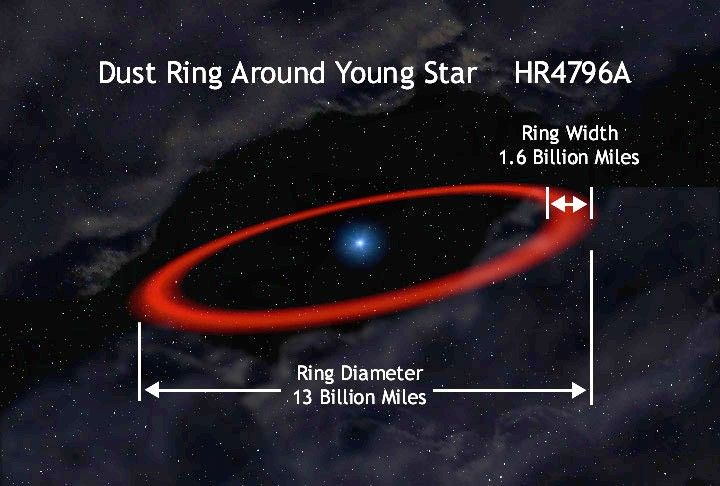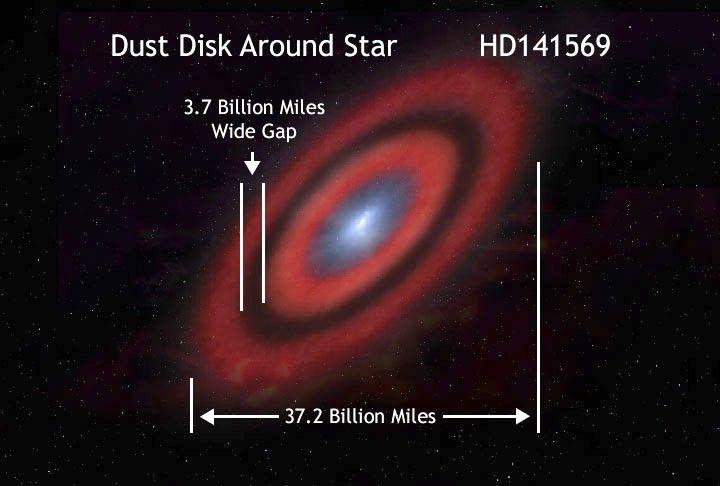Gap In Stellar Dust Disk May Be Swept Out By Planet
STScI-PR99-03a
Astronomers using NASA's Hubble Space Telescope are excited to find a dark gap dividing an immense dust disk around a young, but fully formed star – like a wide groove in a phonograph record. An unseen planet may have gravitationally carved out the 3.7 billion mile-wide rut.
The star, known as HD 141569, lies about 320 light-years away in the constellation Libra. Hubble shows that the disk around HD 141569 appears to come in two parts: a bright inner region that is separated from a fainter outer region by a dark band. It superficially resembles the largest gap in Saturn's rings (known as the Cassini division).
Alycia Weinberger, Eric Becklin, Murray Silverstone (UCLA) and their colleagues are reporting their result today at the 193rd Meeting of the American Astronomical Society in Austin, Texas.
"The most obvious way to form a gap in a disk is with a planet," says Weinberger. "The planet does not have to be in the gap, however. It could either be sweeping up the dust and rocks from the disk as it travels in its orbit around the star, or the gravity of the planet could knock the dust out of one part of the disk."
The vast disk is 75 billion miles across, or about 13 times the diameter of Neptune's orbit. The inner edge of the gap is 21 billion miles from the star. The relatively narrow gap (i.e. 5 percent of the disk's diameter) lies approximately halfway between the inner and outer edges of the disk.
Though already a fully formed, "adult" star, HD 141569 is relatively young, probably only 1% through its lifetime as a stable star. The star is nearly three times more massive and 22 times brighter than our Sun.
HD 141569 was first identified as a source that might have a disk in 1986 as a result of observations done with the Infrared Astronomical Satellite (IRAS) which showed that it had an excess of warm dust around it.
Thermal radiation emitted by the warmed dust was observed in images taken last June at the W. M. Keck Observatory by Murray Silverstone and a team of astronomers from UCLA and University of Pennsylvania. "The part of the disk which is warm enough to be seen in the Keck images corresponds to the inner part of the disk in the HST image," says Eric Becklin of UCLA, "The dust outside the gap is too cool to be seen in the Keck images."
Light from the central star which was reflected from dust particles in the disk was captured by Hubble's Near Infrared Camera and Multi-Object Spectrometer (NICMOS) at a wavelength of 1.1 microns. At the distance of HD 141569, the crisp resolution of the telescope and camera combination reveals structures as small as 1 billion miles across.
Dust disks surrounding newly forming stars are common, but only a small number of adult stars are known to have disks; of these, only a handful have been imaged. Astronomers believe these disks must form and/or be replenished when older rocks and debris collide and break up into small particles.
These early results are part of a survey of environments around young main sequence stars, being conducted by the NICMOS Instrument Definition Team and their collaborators. In addition to HD 141569, the team has also found that the disk around the star HR 4796A appears to be confined by one or more unseen low mass companions.
Dust Ring Around Star Offers New Clues Into Planet Formation
STScI-PR99-03b
NASA's Hubble Space Telescope (HST) has given astronomers their first view of a novel type of structure seen in space - a dust ring around a star.
Superficially resembling Saturn's rings - but on a vastly larger scale - the "hula-hoop" around the star HR 4796A offers new clues into the possible presence of young planets.
"The rings surrounding the giant planets in our own solar system are held in place by the gravitational force of moons orbiting nearby," explains Brad Smith of the University of Hawaii. "The narrow width of the HR 4796A ring implies that it also is held in place by unseen bodies, most probably planets or protoplanets."
Smith, Glenn Schneider (University of Arizona) and their colleagues reported the discovery today at the 193rd Meeting of the American Astronomical Society in Austin, Texas.
HR 4796A is about 70% larger than the Sun and probably less than 10 million years old. "Considering our own solar system to be middle aged, HR 4796A would be a mere infant," says Smith. "It is especially interesting this stellar ring is so young, indicating planetary bodies have already formed in less than 10 million years."
Unlike the extensive disks of dust seen around other young stars, the HR 4796A dust ring, 6.5 billion miles from the star, is tightly confined within a relatively narrow zone less than 17 Astronomical Units wide. (An Astronomical Unit is the distance from the Earth to the Sun.) For comparison, the ring width is approximately equal to the distance separating the orbits of Mars and Uranus in our own solar system.
All dust rings, whether around stars or planets, can only stay intact by some mechanism confining the dust. Otherwise, disruptive forces, such as those produced by particle collisions, light pressure, etc., would cause the ring to spread both inward and outward until it finally lost its identity.
The star HR 4796A first drew attention in 1991 when Michael Jura (UCLA) reported an unusual amount of dust surrounding the star, based on observations made by IRAS (Infrared Astronomical Satellite) in 1984. Last year, David Koerner (Univ. Pennsylvania) and others announced ground-based thermal infrared data indicating that the dust around HR 4796A is in the form of a disk, with relatively clear inner region that lies within 6 billion miles from the star. "However, the thermal infrared data lacked the resolution to precisely define the geometry of the disk," says Smith.
Just visible to the naked eye, HR 4796A is located 220 light-years away in the southern constellation of Centaurus. The ring is about a thousand times fainter than the star. "The angular extent of the HR 4796A disk is equal to that of a dime seen at a distance of more than 4 miles," says Schneider. To image it HST scientists had to use a coronagraphic camera on Hubble's Near Infrared Camera and Multi-Object Spectrometer (NICMOS). A coronagraph blocks out the glare of a star's light (just as the Moon blocks the Sun's light during a solar eclipse) so that much fainter surrounding material can be seen.
"The ring's color is reddish-grey," says Schneider, "which shows that it is not made up of interstellar dust particles." Although the origin of the dust remains unknown, a good possibility is that it is composed of debris from collisions between planetesimals (comet-like bodies) that are also confined within the ring.

































